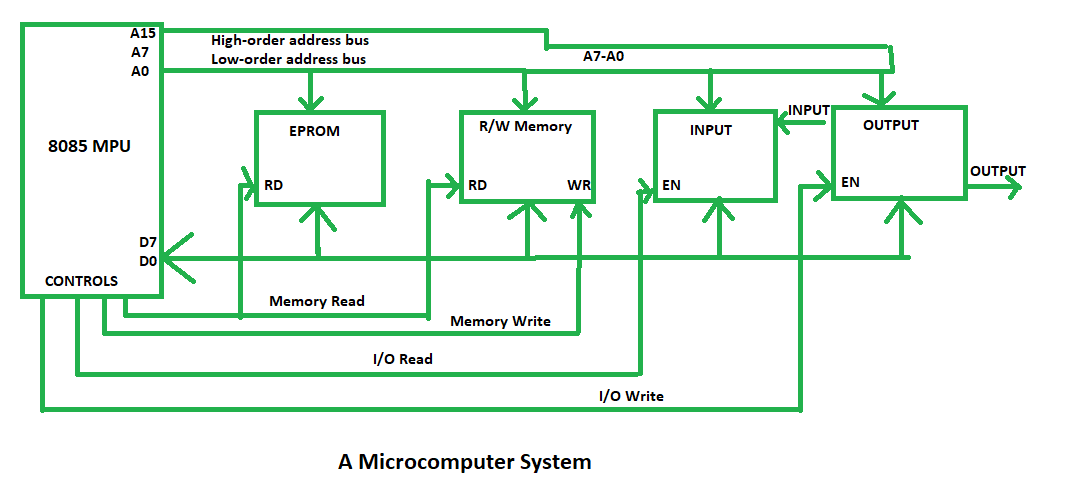Introduction of Microcomputer System
Last Updated :
12 May, 2023
Introduction of Microcomputer System
Microcomputer systems are small and inexpensive computers that are widely used in various applications. The 8085 microprocessor is an example of a Microcomputer System. A microprocessor system contains two types of memory that are EPROM and R/WM, Input and Output devices, and the buses that are used to link all the peripherals (memory and I/Os) to the MPU.
The Microprocessor Unit (MPU)
The MPU is the brain of the microcomputer system. It contains the arithmetic and logic unit (ALU) and the control unit (CU) that work together to execute instructions. The 8085 microcomputer system has 16 address lines ranging from A0 to A15 that are used to address memory. The lower-order address bus A0-A7 is used to identify the input and output devices.
Memory
There are two types of memory in the microcomputer system: Erasable Programmable Read-Only Memory (EPROM) and Random-Access Read-Write Memory (R/WM). EPROM is a type of memory that can be programmed once and can be erased by exposing it to ultraviolet light. R/WM is a type of memory that can be both read and written to. The MPU communicates with memory through memory read and memory write control signals.
Input and Output (I/O) Devices
The microcomputer system contains input and output (I/O) devices that allow the system to interact with the external environment. The microcomputer system has 8 data lines, D0-D7, which are bidirectional and common to all devices. The microcomputer system generates four control signals: memory read, memory write, I/O read, and I/O write. These signals are connected to different peripheral devices.
Interfacing Devices
The MPU communicates with only one peripheral device at a time by enabling that peripheral through its control signal. For example, to send data to the output device, the MPU places the device address (or output port number) on the address bus, data on the data bus, and enables the output device by using its control signal I/O Write. After that, the output device displays the result.
The other peripheral devices that are not enabled remain in a high impedance state called Tri-state. The bus drivers increase the current driving capacity of the buses, the decoder decodes the address to identify the output port, and the latch holds data output for display. These devices are called Interfacing devices. Interfacing devices are semiconductor chips that are necessary to connect peripherals to the bus system.
In summary, the microcomputer system is a small and inexpensive computer that contains an MPU, memory, input and output devices, and buses that connect all the peripherals. The microcomputer system communicates with peripherals through control signals, which are connected to different peripheral devices. Interfacing devices are necessary to connect peripherals to the bus system.
The block diagram of a microcomputer system is shown below:

Advantages:
Flexibility: A microcomputer system can be customized to meet the needs of a wide range of applications. It can be programmed to handle a variety of tasks, and its components can be easily upgraded or replaced as needed.
Cost-effective: Microcomputer systems are generally less expensive than larger computer systems, which makes them a cost-effective solution for many applications.
Compact size: Microcomputer systems are typically small and compact, which makes them ideal for applications where space is limited.
Ease of use: Microcomputer systems are generally easy to use, particularly for individuals with basic computer skills. They typically come with user-friendly interfaces and software that make them easy to operate.
Disadvantages:
Limited processing power: Microcomputer systems typically have limited processing power compared to larger computer systems. This can limit their ability to handle complex tasks or run resource-intensive software.
Limited memory capacity: Microcomputer systems typically have limited memory capacity compared to larger computer systems. This can limit their ability to handle large amounts of data or run complex software.
Limited I/O options: Microcomputer systems typically have limited I/O options compared to larger computer systems. This can limit their ability to interface with other devices or handle complex I/O operations.
Limited expansion options: While microcomputer systems can be upgraded or replaced, they typically have limited expansion options compared to larger computer systems. This can limit their ability to grow or adapt to changing needs over time.
Like Article
Suggest improvement
Share your thoughts in the comments
Please Login to comment...